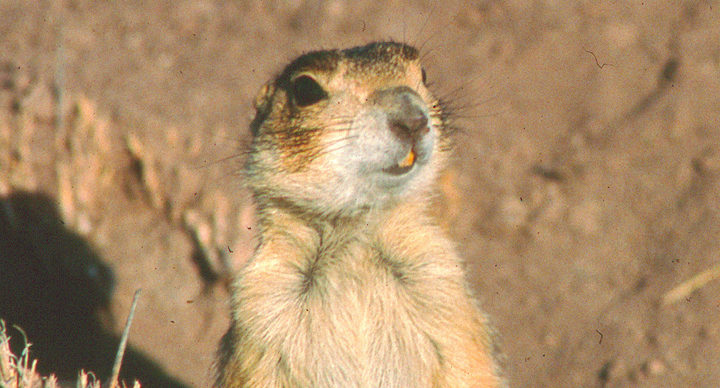An increasing amount of evidence shows that a number of animals have language or language-like properties. I summarize this information with a variety of examples in Chasing Doctor Dolittle: Learning the Language of Animals; a short video on the topic is also available for viewing.

In 1960, linguist Charles Hockett published a list of thirteen design features of human language, which have become the gold standard for what linguists will accept as indicating that an animal species has a language. Some of these features are found in any signal-producing system, while the following seven (explained in more detail later) represent key elements distinguishing language from mere communication: semantics, arbitrary, discrete, displacement, productivity, duality, cultural transmission.
When we try to apply these features to other animals we are faced with a conundrum. We need a Rosetta Stone to give us the key to unlock a species’ system of language or communication.
In this post I discuss one of the best available examples of animal language, which comes from my work with prairie dogs. Prairie dogs are ground squirrels (1kg, 0.1m long), living in extensive burrow systems, called towns or colonies, in North American grasslands. They have alarm calls utilized to warn each other about approaching predators. Their escape behaviors involve running to their burrows and diving inside where predators cannot reach them.
Within a prairie dogs’ town there might be hundreds of animals, and the ground is partitioned into territories, occupied by discrete social groups. When a predator appears, one or more prairie dogs give an alarm call that to our ears sounds like a bird chirping. Other prairie dogs run to their burrows to escape the predator.
The entire sequence of predator appearing, prairie dogs alarm calling and running to their burrows offered my students and me a means of decoding the language of the Gunnison (Cynomys gunnisoni) prairie dogs’ language.
We videotaped the appearance and behavior of the predator as it approached the colony, recorded the alarm calls prairie dogs produced in response to the predator, and videotaped prairie dogs’ escape responses. Subsequently, on another day when no predator was present, we played back the recordings made in response to the predator that had previously appeared and videotaped prairie dogs’ escape responses to see if prairie dogs’ responses when no predator was present were the same as the responses when the predator appeared.
In a series of experiments we found that prairie dogs have different alarm calls and different escape responses for different predator species. Predators include coyotes and domestic dogs that hunt prairie dogs’ on the ground, humans who shoot them, and red-tailed hawks that swoop down from the air. Prairie dogs’ escape responses differ, depending on the species of predator.
For coyotes, prairie dogs immediately run to their burrows, and stand on their hind legs at the burrow opening, watching the progress of the coyote through the colony. Prairie dogs who were below ground before the coyote appeared, emerge and join those standing at the burrow entrances. This is related to the hunting strategy of coyotes, who will often find a concentration of prairie dogs and lie down on the ground near those burrow openings, waiting for unwary prairie dogs to emerge. By watching the progress of the coyote, prairie dogs get an excellent idea of where the predator is likely to lie down and wait for them.
For domestic dogs, prairie dogs stand up on their hind legs wherever they happen to be foraging, and watch the progress of the dog through the colony. They only run for their burrows if the dog gets close to them. However, as with coyotes, prairie dogs that were below ground emerge from their burrow opening to stand and watch the dog. Domestic dogs aren’t efficient predators of prairie dogs; unlike coyotes, they don’t lie down next to burrows, so prairie dogs don’t need to find immediate safety in their burrows but still need to see where the dog is going.
For red-tailed hawks, prairie dogs in the immediate flightpath of the swooping bird run to their burrows and dive inside, without standing at the lip of the burrow. Prairie dogs that aren’t in the hawk’s flightpath stand on their hind legs wherever they happen to be foraging and watch the progress of the bird.
For humans, the entire colony of prairie dogs immediately runs to their burrows and dives in, without emerging or standing at the lip. prairie dogs have been hunted since ancient times by Native Americans with bows and arrows. Today, prairie dogs are shot for sport. Be it bows and arrows or bullets, prairie dogs don’t have much time to escape, and become easy targets if they stand at their burrow lips.
Just as the escape responses differ, we found that the alarm calls for different predator species differ in their acoustic structure. Prairie dogs have acoustically different alarm calls for coyotes, domestic dogs, red-tailed hawks and humans.
This gave us the Rosetta Stone we needed to begin to unravel prairie dogs’ language system. In a series of experiments, we were able to show the following design features in their alarm calls:
- Semantics (just as words in human languages have distinct meanings, signals produced by animals must also have distinct meanings): prairie dogs have distinctly different alarm calls for different species of predators. Furthermore, they can vary acoustic elements within a call for a predator species to describe its size, color, and shape.
- Arbitrary (an arbitrary symbol has no direct connection to what it represents, e.g. “green” doesn’t tell anything about what the color looks like, in contrast to an iconic symbol, e.g. “bow-wow” [barking] used to describe a dog): prairie dogs’ calls are completely arbitrary with a series of acoustic frequencies changing as a function of time within an alarm call.
- Discrete (each symbol has to be a discrete unit, like words in the sentence are all discrete units): Each prairie dog’s alarm call is a discrete unit.
- Displacement (capacity to provide information about events occurring in different locations or time periods from the speaker): prairie dogs can indicate the presence of a predator that is far away, with one experiment showing that prairie dogs were able to consistently affix an apparent label of a gun to a person who once fired a shotgun and then subsequently appeared without a gun during the month of the experiment.
- Productivity (capacity to make up new words, e.g. “cell phone” didn’t exist until recently): prairie dogs can coin new “words” for objects they’ve never seen before, such as a black oval, a triangle, and a circle.
- Duality (language has to have smaller units that can be combined into bigger ones: phonemes into morphemes, words into sentences): an analysis of the structure of prairie dogs’ alarm calls showed that they were composed of phonemes, like human words. For the alarm calls for different species of predators, most of the same phonemes were used, but the proportion of phonemes used for different species of predators was different.
- Cultural Transmission (languages are learnt): An experiment showed that new-born prairie dogs emerging from their burrows have a non-specific alarm call for all predators, but over time, the specificity increases, suggesting that some aspects of the call are under genetic control and other aspects are determined by cultural transmission.
Prairie dogs represent one of the best animal language-like systems that’s been decoded. But there are a number of other examples of animals with language-like properties. For example, Sagebrush lizards have been shown to have a grammatical system in their head bobbing, tail lifting, and arm lifting. Both Japanese tits and American chickadees’ vocalizations have syntax, and blackbirds’ calls have recursion.
In all of these cases, the behavioral context represents a starting point for decoding the language of the communication system. As with prairie dogs, the behavioral context is the Rosetta Stone.
Con Slobodchikoff, PhD, is Professor Emeritus of Biology at Northern Arizona University, and founder and CEO of Zoolingua, a company that is using artificial intelligence technology to decode animal communication. His research involves the study of animal languages and communication. His book on animal languages, Chasing Doctor Dolittle: Learning the Language of Animals (St. Martin’s Press, 2012) explores the issues of animal languages.



